It’s is an oft-repeated question for all the right reasons. Both hold prominent positions in the eCommerce industry, are highly functional, and can get you up and running with your eCommerce store in no time!
But which one is the right mix of functionalities and features for your store?
Well, in this article, we’ll be covering both the eCommerce platforms in terms of the features they provide. Hopefully, reading through the article will give you a serious grasp on both the platforms and prove as a catalyst to your decision-making process.
So, let’s start!
Shopify vs WooCommerce: At a Glance
Before we get to the good stuff, let’s give you an overview of the platforms.
Shopify

A complete eCommerce solution for businesses, Shopify provides just about anything you need to get started and eventually succeed with your eCommerce venture. It provides all those features while taking care of all the technicalities on its end.
WooCommerce
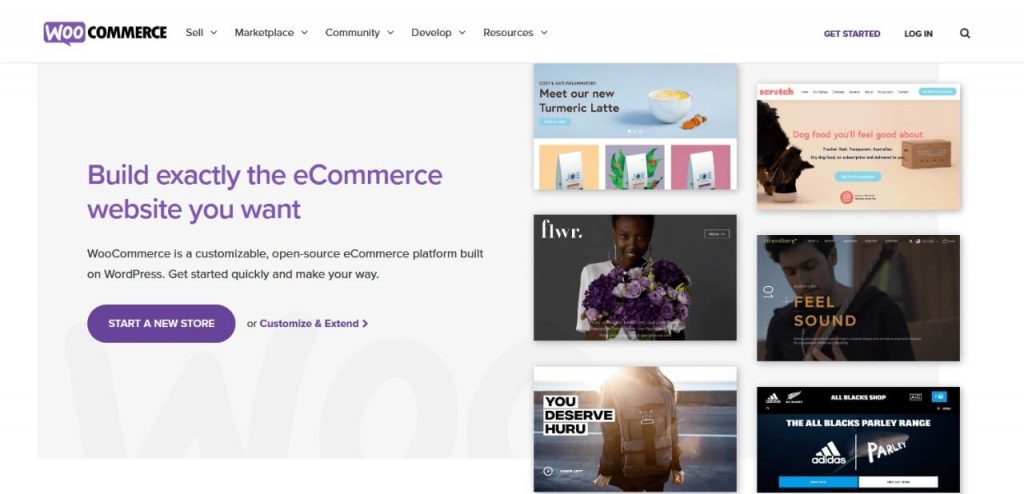
An open-source plugin for the ever-powerful WordPress CMS, WooCommerce is a highly customizable and functional eCommerce solution. If you have a WordPress website, you can get up and running with WooCommerce in no time.
With that in mind, it’s time we compare the two platforms in terms of features.
Shopify vs. WooCommerce – Pros and Cons
Both WooCommerce and Shopify have their pros and cons. After a thorough comparison, we have concluded the following pros and cons:
Shopify Pros and Cons
Pros
- Fair, simple, and clearly defined payment structure
- Easy access to thousands of apps for store extension.
- Professionally designed, beautiful themes
- Tons of theme options to choose from
- Shopify makes handling everything from hosting to security easy and hassle-free
- You can launch an impressive-looking online store within a few minutes
- Shopify simplifies dropshipping
- Highly responsive customer support
Cons
- Your control over your site is limited
- Limited customization options as compared to WooCommerce
- No half-yearly or annual payment plans
WooCommerce Pros and Cons
Pros
- Excellent customization and controls
- Tons of themes and plugins
- WordPress’s substantial online community provides excellent support
- Free WooCommerce plugin
- WooCommerce offers free configuration on WordPress
Cons
- Some might find it WooCommerce a bit difficult to use
- WooCommerce can become more expensive due to themes, hosting, and plugins
- It does not provide enough support for managing hosting, security, and backups.
Shopify vs WooCommerce – Ease of Use and Customization
Since not everyone can be a developer or a designer, user-friendliness is an essential aspect of an eCommerce platform. Let’s see how both Shopify and WooCommerce compare with each other in terms of user-friendliness.
Shopify
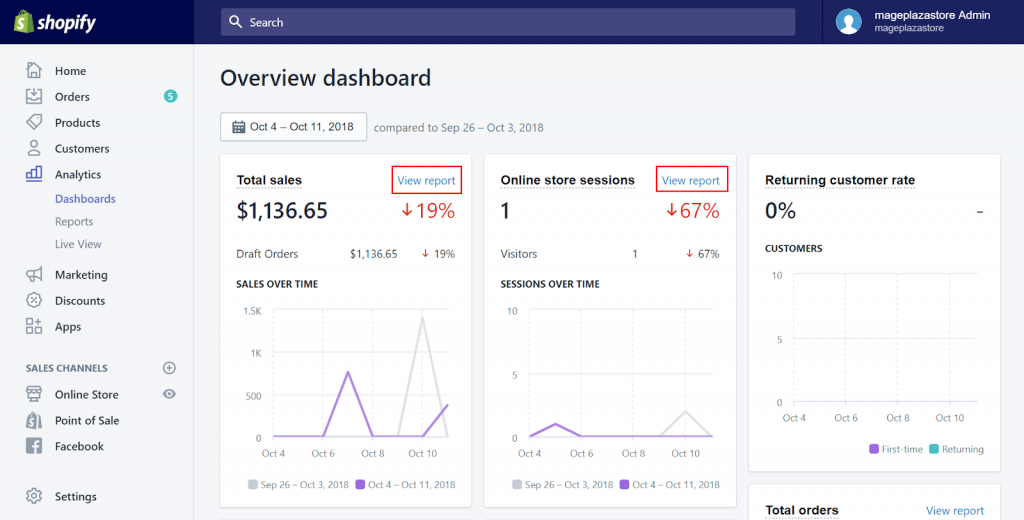
In terms of usability, Shopify is super easy! After you’ve signed up, all you have to do is pick a design and start with your operations. With Shopify, issues like hosting, server, security, compatibility, and others aren’t your concern.
In terms of customizations, Shopify doesn’t lag, but it doesn’t promise too much customization. Due to its closed source nature, it doesn’t provide you in-depth customizations. Moreover, you’re limited to using Shopify’s tools for customizations – making personal branding a challenge.
WooCommerce
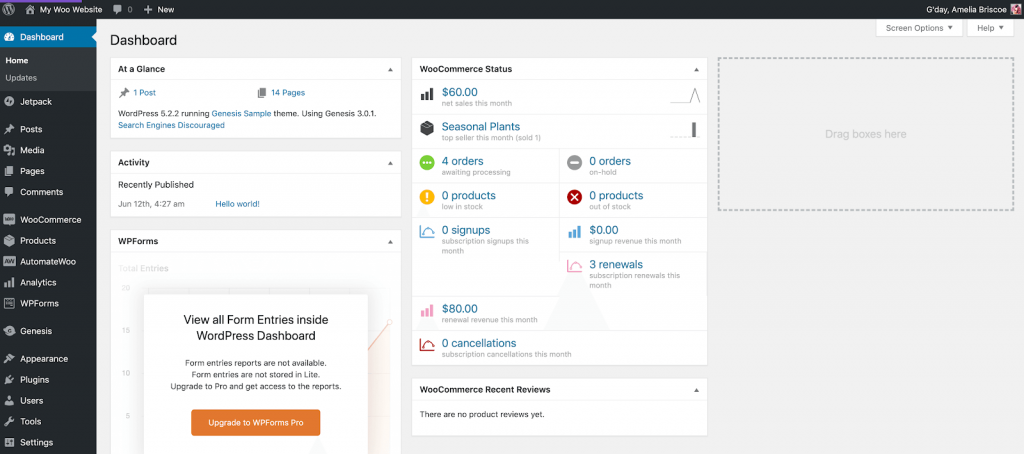
With WooCommerce, you have to set everything up yourself. Unlike Shopify, you have to purchase a domain name, hosting, installing WordPress, and then WooCommerce. On top of that, security, servers, compatibility issues, and more are very much a headache for you.
But where it lacks in ease of use, it makes up for in droves with customizations. From header to footer, WooCommerce gives you total control over the functionalities of your website.
Its vast collection of themes, page builders, and plugins ensure that your branding efforts are highly effective.
Shopify vs. WooCommerce – Ecommerce Market Share
Let’s discuss the current market share of Shopify and WooCommerce. But before that, it is essential to remember that you shouldn’t select an eCommerce solution based on its popularity. However, learning about these trends will help you identify the hosting eCommerce platform that your competitors might be using.
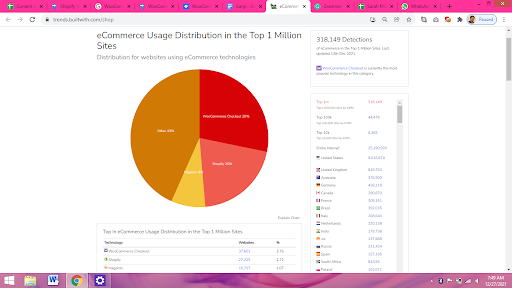
According to the statistics by BuiltWith, as of December 2021, eCommerce usage distribution among the top 1 million sites, WooCommerce holds the most significant share, 28%. Shopify comes in second with 20% and Magento in third with an 8% market share.
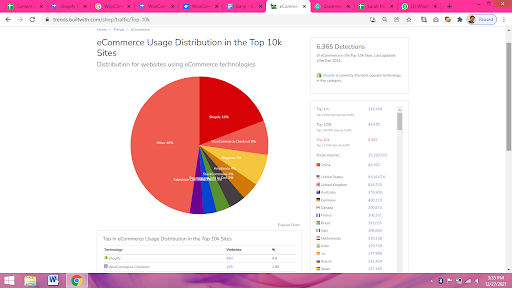
On the other hand, if you look at the Top 10k Sites, you will see that Shopify holds a more significant share with 19%, whereas WooCommerce has only 8% market share. These statistics show that Shopify is a more popular choice amongst higher authority sites.
Suppose you observe the Google Trends for the past five years. In that case, it’s evident that although both WooCommerce and Shopify have had pretty steady growth, Shopify has surpassed WooCommerce and shows more promising trends than WooCommerce.
Shopify vs WooCommerce – Payment Methods
As a general rule, it’s best to have multiple payment options for your eCommerce store. Both Shopify and WooCommerce provide you this facility but with their variations. Let’s see which one can add more value to your store:
Shopify
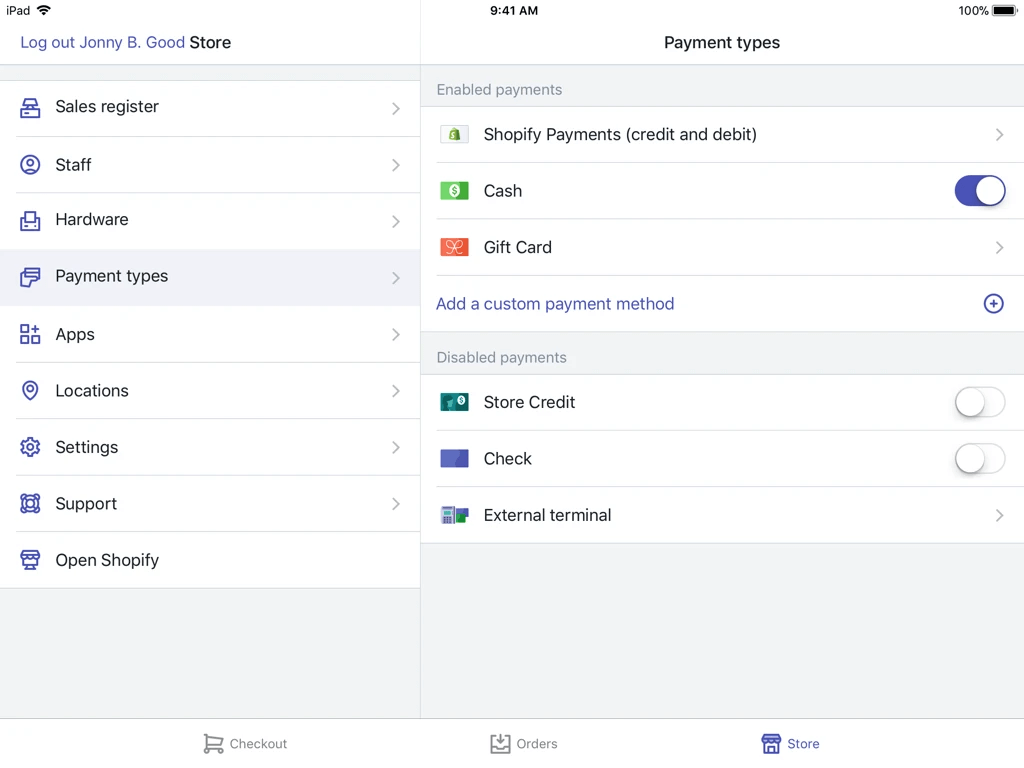
As discussed, Shopify provides multiple payment gateways but charges 2% on every transaction. Combine that with the fees charged by the payment gateway itself, and what you’re getting is significantly lesser in terms of the bottom line.
WooCommerce
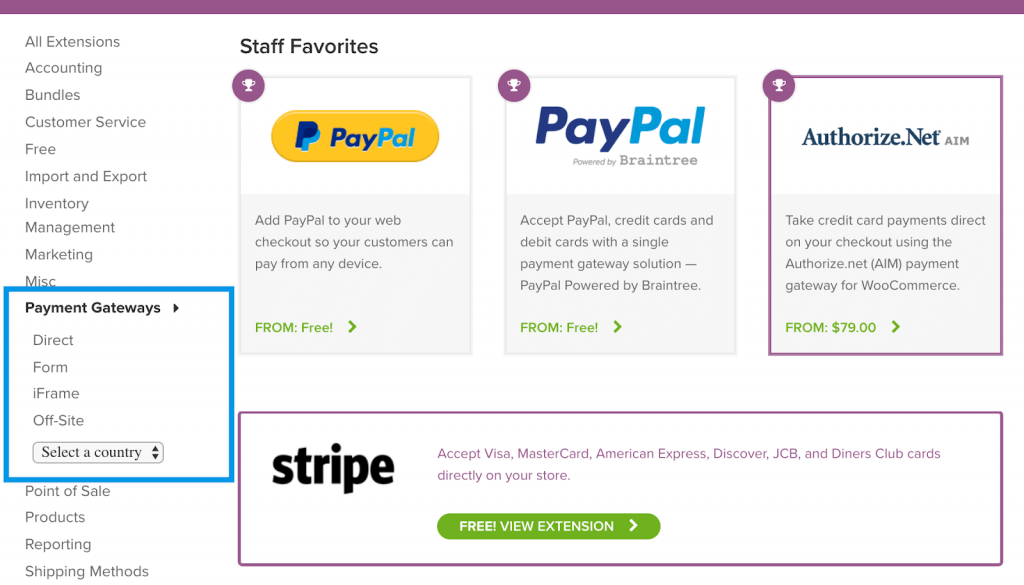
Similar to Shopify, WooCommerce supports multiple payment methods. Whether it be an international or local payment gateway, you’re covered by WooCommerce and its numerous add-ons for those methods.
The best part about WooCommerce’s payment integrations is that they don’t charge you any fees. All of what you’re paying for is the integration itself. The platform doesn’t charge you any percentage fees.
Shopify vs WooCommerce – Scalability and Growth
Growing pains are a severe problem for most business owners when their operations get bigger. Let’s see which platform provides more support for such growing pains.
While both can handle a scaling business’s traffic requirements, the platforms are very different in their approach towards it.
Shopify
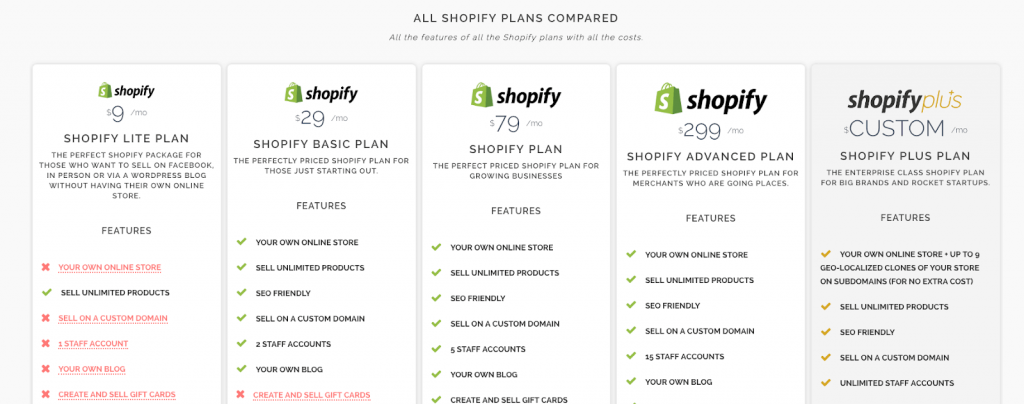
As discussed above, Shopify handles all the technical aspects of your eCommerce store. When it comes to scaling your website, this can prove beneficial since you don’t have to focus on the growing pains.
You can do that with the help of Shopify’s plans. If you feel that your current traffic is too much for your current plan, upgrade your account. Like any other hosted platform, the catch to this upgrade is that you have to pay extra to Shopify.
WooCommerce
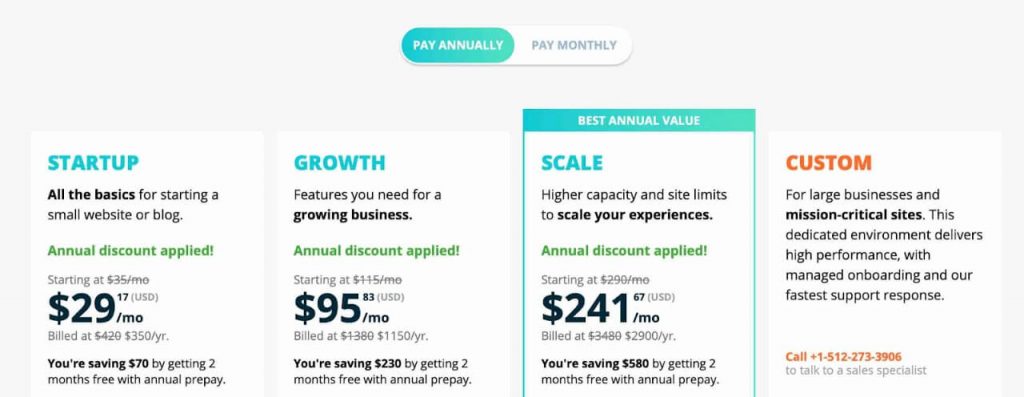
Since the platform is a self-hosted one, and you have to tackle the technical issues yourself, scalability can be a real drag on your operations.
A simple solution to scalability concerns on WooCommerce is to upgrade your hosting plan. If scaling is a problem even after you’ve upgraded the host, you can migrate to another, preferably a managed WordPress host, to curb those concerns.
Contrary to contemporary criticism, WooCommerce is very much scalable. The best part about it is that you can manage your growth incrementally – allowing you to grow just at the right time.
Shopify vs. WooCommerce – Support
Both platforms are relatively easy to use. If you find yourself in a pinch, there are tons of resources to use. But what if you wanted to do something new and needed an expert opinion? Which platform would let you do that?
Shopify
If you’re looking to do something unique, then Shopify has your back with its extensive support. Since they’re the ones controlling the backend, they’ll provide you their expertise on any functionality you wish to integrate.
In terms of support, you get 24/7 support through multiple mediums. If you don’t want to go through the support process, you can read up on Shopify’s documentation, how-tos, and knowledge base tutorials.
Bear in mind that while Shopify does provide support, it only does so for Shopify’s native applications and not any third-party themes or plugins.
WooCommerce
Being the most popular eCommerce platform, WooCommerce is not devoid of support options. They’re different, but they’re there when you need them.
First off, the WooCommerce website has an extensive collection of tutorials and guides that you can use to help yourself. From documentation, how-to’s, and knowledge base article, WooCommerce itself has no shortage of content in the matter.
Being a self-hosted platform, the only support option you have is in the form of asking your hosting provider about server issues. That’s it.
If you’re having trouble with your themes and plugins, then you can either ask the plugin developer or the multitude of WooCommerce support forums spread across the internet. Hopefully, a single Google search will put you in the right place.
Shopify vs WooCommerce – Integrations and Add-ons
While you can make do with an eCommerce store, you will always need third-party add-ons and integrations to grow your business. Suppose you want to rank for specific keywords or create a newsletter. In that case, integrations are your best friend.
Let’s look at both Shopify and WooCommerce and how they stack up against one another in this context.
Shopify
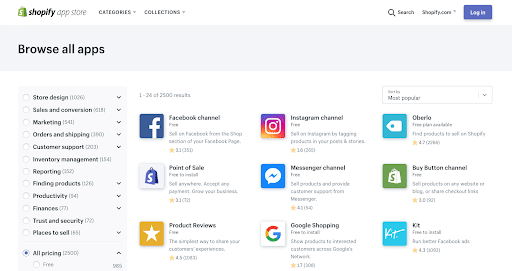
Shopify comes with its app store, where you can purchase hundreds of add-ons for your site. On top of that, it also has a robust API that streamlines your business processes.
There are plenty of paid and free apps you can use. From lead generation tools to email marketing, SEO, and eCommerce specific applications – it’s got a comprehensive collection at the ready for you.
WooCommerce
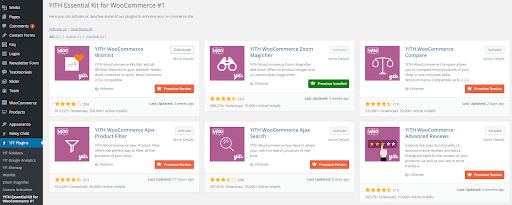
If you’ve ever used WordPress, you would know how useful it’s plugins can prove for your website. WooCommerce is built on top of WordPress and gives you access to the WordPress plugin store.
From payment integrations, lead generation, SEO, security, and performance optimization – WooCommerce is a class apart when it comes to its support for paid and free third-party features.
The only problem with the store is that sometimes, you encounter plugins and themes that are outdated and incompatible with your WordPress version. Because of this, it’s always best to select trustworthy plugins because it might lead to security issues in the future.
Shopify vs. WooCommerce – SEO friendliness
SEO plays an essential part in the success of your business. Although advertising is the most effective medium for attracting traffic to your website, it is also essential to improve your website’s SEO rating so that your customers can find your store organically. Shopify and WooCommerce help enhance SEO in the following way.
Shopify
Shopify makes SEO management easy and simple. It allows you to quickly and conveniently edit meta titles and descriptions of your products. You can also add keywords to pages titles, meta descriptions, ALT tags, and the entire page’s content.
WooCommerce
WooCommerce gives a vast selection of SEO plugins to choose from. You can also access their free SEO plugin that helps you optimize social media. It is an on-page optimization tool with the ongoing addition of features.
Both Shopify and WooCommerce have their pros and cons when it comes to SEO friendliness. However, you can’t entirely rely on these platforms for success; publishing relevant and exciting content is the primary key to success.
While comparing Shopify and WooCommerce, it becomes evident that their basic blogging capabilities might fall short for ambitious e-commerce businesses. To fully exploit the power of content marketing, considering an external tool becomes necessary. For instance, there are tools like Shopify blog app called Bloggle, a Shopify-focused app, that offer advanced SEO and design functionalities to enhance your blog’s performance. With these tools, you can amplify your organic reach and conversion rate. Therefore, while evaluating these platforms, it’s crucial to consider potential add-ons for your blogging needs.
Is it better to use dropshipping from Shopify or WooCommerce?
Let’s compare dropshipping with Woocommerce vs. Shopify.
Dropshipping entails having no inventory. When a consumer buys something from your eCommerce store, simply buy it from a 3rd party and mail it to them. This ensures you can save money on warehousing and storage while still getting orders delivered on time.
Shopify includes app connectors for most famous marketplaces such as AliExpress, Oberlo, Printify, and others, but keep in mind that you must pay separate membership charges for each of these apps, which can add up quickly.
If you utilize one of the versatile Woocommerce dropshipping plugins, Woocommerce dropshipping is less expensive. With the correct plugins, you can acquire products and fulfill orders. You could even let vendors sell on your site. Still, you must adhere to minimum order restrictions, membership fees, and other expenses.
FAQs
How simple is it to switch to Shopify from WooCommerce?
Switching to Shopify from WooCommerce is more accessible than the reverse. This is due to Shopify’s committed support team, who is ready to help you join their platform. We suggest calling the support staff to receive as much assistance as possible. Shopify also includes online guidelines to guide you through the steps, as well as specific data transfer software.
How simple is it to go to WooCommerce from Shopify?
During a transfer like this, you won’t be able to recreate the look of your website perfectly. Nevertheless, every aspect of the database to the blog content and items may be effortlessly transferred. We recommend looking for tutorials to learn the best approaches. In our opinion, the ideal way is to use a WordPress plugin. There are a few; however, the Cart2Cart plugin is explicitly designed for Shopify users. If any of this scares you, you could always employ someone.
Conclusion
So, Shopify or WooCommerce? Who is the winner?
It will sound cliché, but the only possible winner here is you provided that you select the right platform. Both these platforms are great, but at the end of the day, if it doesn’t fulfill a user’s needs, it’s not worth it.
Hopefully, after reading through this post, you have an idea on how to get started with the right platform that’s made for you.
Read Also
- 15 Best WordPress Caching Plugins
- SiteGround vs Bluehost
- 6 Ways To Boost Your Customer Experience In Ecommerce
- How to Choose the Right Type of SSL Certificate
- Elfie WordPress Theme Review
- WordPress Security Guide
- How To Choose A Right WordPress Development Agency
- WooCommerce Shortcodes Guide
- 5 Popular B2B eCommerce Trends
- The Influence of Container Security on WordPress

